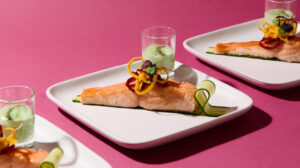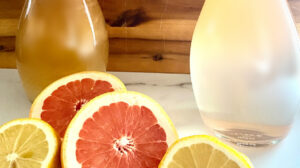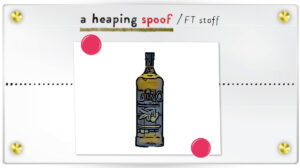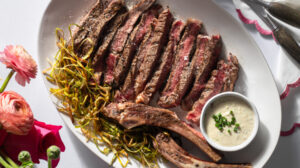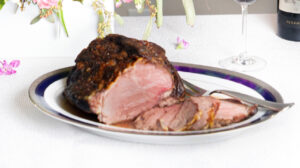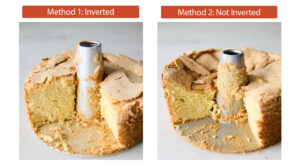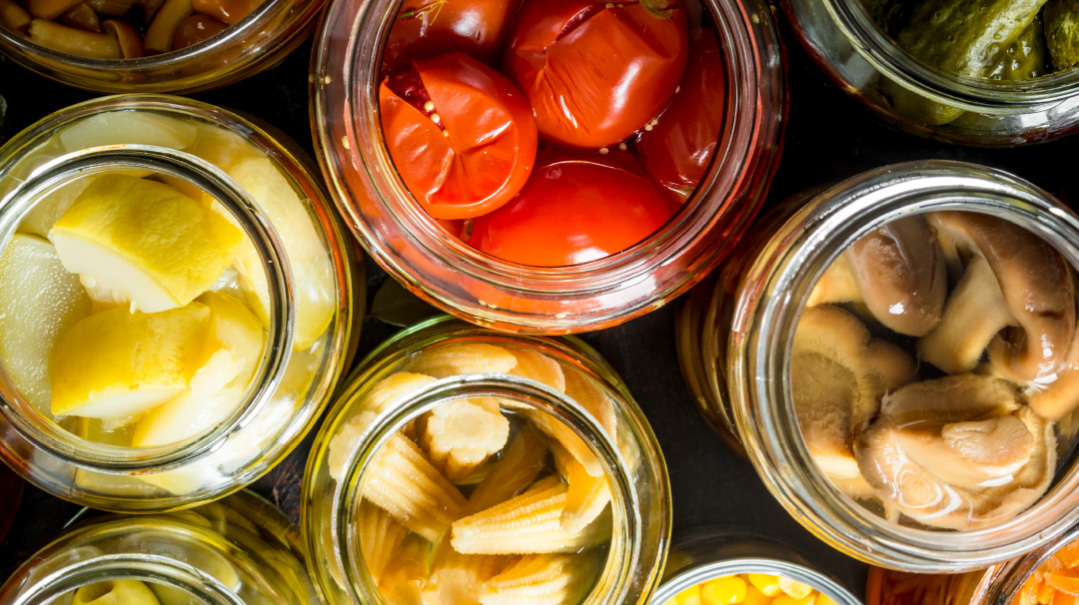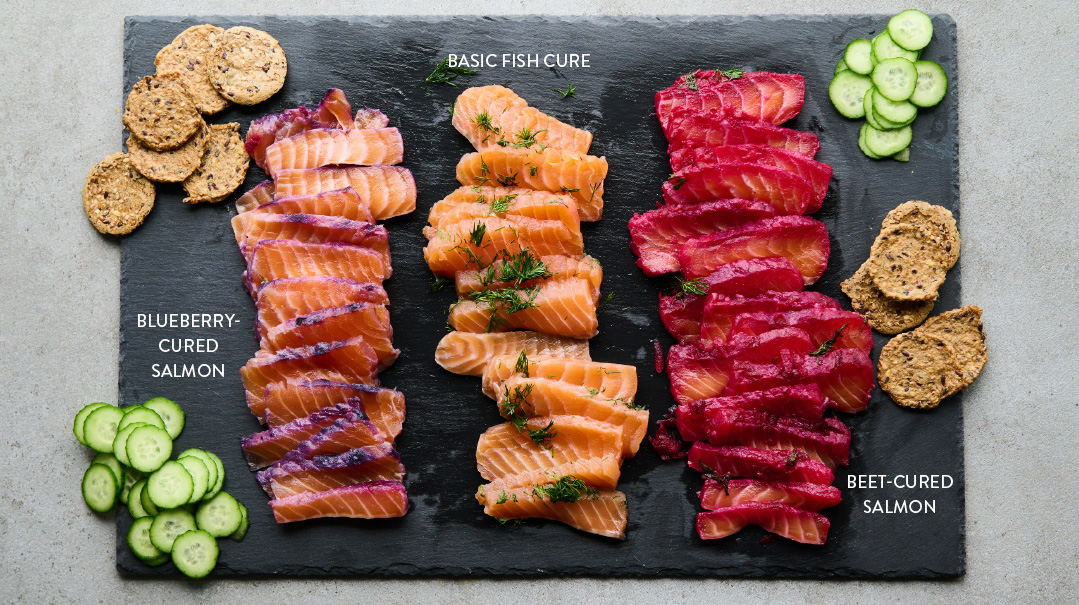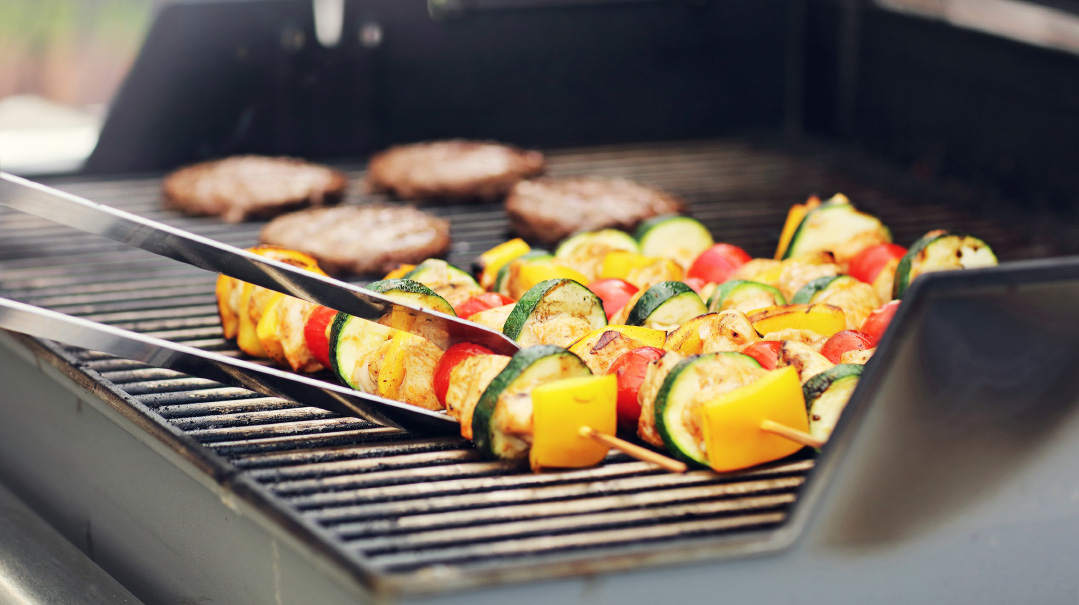From Chef’s Knives to Quail Eggs

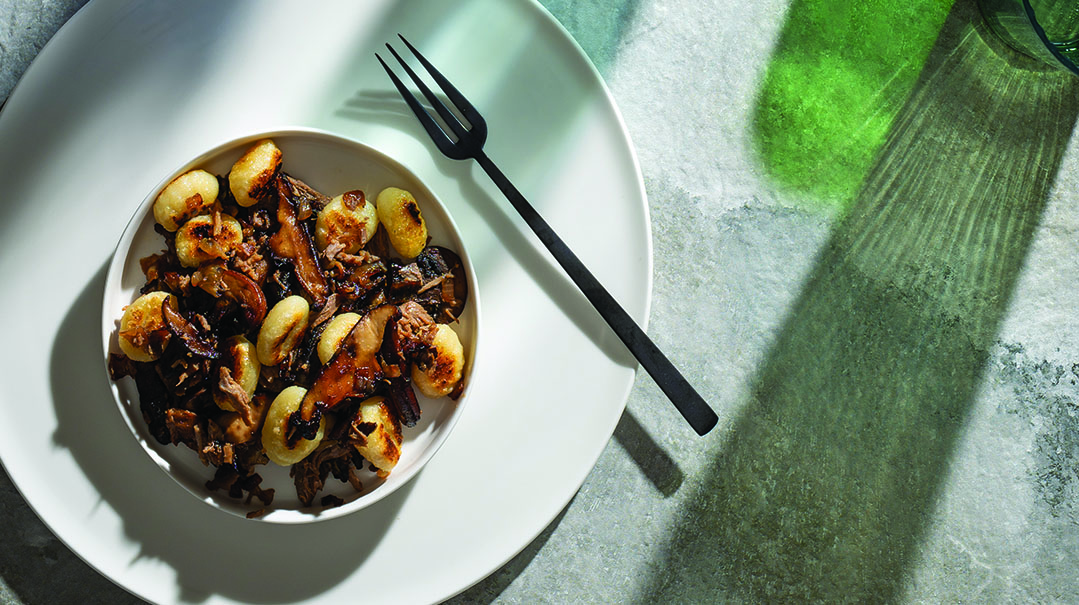
(Duck Gnocchi with Mushroom-Onion Wine Sauce)
Food and prop styling by Renee Muller
Photography by Hudi Greenberger
We’ve come a long way since the generation of “children should be seen and not heard,” but Chanie Nayman sure piqued my interest when she assigned me to interview Dovid Biderman — mostly because he was my student last year in sixth grade and didn’t once bring up his cooking prowess, despite knowing I was a food writer (yeah, yeah, I start them young)!
After a sampling of duck confit over gnocchi and aged beef with a balsamic reduction, the idea of hanging out with students after the last day of school was no longer off-putting. This bar mitzvah boy’s food knowledge and advice rivals that of adult chefs I’ve spoken to.
At seven years old, Dovid Biderman began helping with salad prep (supervised, of course). When he was eight, he started baking the basics: chocolate chip cookies, brownies, biscotti. At ten, he was coming up with his own recipes based on other recipes he liked. Spinoffs, if you will.
As time went on, new tools and gadgets joined the kitchen, as did more ideas. Here are some samplings of the food world according to Dovid.
Tools
The time one wastes by prepping food with the wrong tools is silly. Just ask Dovid.
Knives: Every tool in the kitchen has a purpose, but probably the most important one is the knife. Personally, I like Japanese knives. They’re expensive and harder to care for, so I don’t use them exclusively. You can’t put them in the dishwasher, and you can’t let them sit in water.
I’ve found that most people who aren’t into food use serrated knives, but I believe a chef’s knife is better, sharper, and slices through food more easily. It’s also more effective for crushing. I like to use Japanese knives when I want to slice something really thin to use for a garnish.
Meat Slicer: Not every home has a meat slicer, but I highly recommend it if you make jerky or want a perfectly even sliced roast. I make bresaola prosciutto, a type of cured meat, which I make out of duck. The thin slices make it tastier.
Air Fryer: An air fryer has a fan that keeps the hot air circulating, which makes the food crispier even without being fried in oil. My favorite way to use it is to air-fry whole brussels sprouts and then halve them and put them back into the air fryer for another round. They’re delicious!
Sous Vide: My siblings bought my mother a sous vide for Pesach two years ago, but the first person to use it was me! I made a London broil, and it came out so soft and juicy. In order to really take advantage of the benefits of a sous vide, it’s good to use a vacuum sealer to lock in the flavor of the food you’re cooking. They aren’t only for roasts!
Now I use the sous vide all the time. I’ve made poached eggs in it, then I took it to the next level, first poaching an egg and then frying it — a new trend called “froached eggs.” You poach the egg in its shell in the sous vide and crack it straight into a hot frying pan. It has the crispiness of the fried egg with the silky softness of a poached egg. Just add salt and pepper.
I’ve also used it to make a delicious garlic-infused oil. I peel and smash fresh garlic, put it into a vacuum-sealed bags with a mild olive oil or a neutral oil like avocado or canola, and leave it in the sous vide at 131°F for three hours.
Cast-Iron Pans:Smack in the middle of the boredom induced by Covid quarantine, my brother-in-law introduced me to cast-iron pans, and I was hooked. A cast-iron pan is coated in oil, which poses a kashrus problem. You have to either buy a kosher one or else burn off the seasoning. You don’t want welts in your cast irons, so it’s very important to clean them gently. I really want to get a Dutch oven, which is a cast-iron pan with an enamel coating that doesn’t require seasoning.
Meater Meat Thermometer: This was an amazing gift from my grandmother. That’s not a typo — the brand name is Meater, and it’s a wireless thermometer that makes cooking meat so much more accurate. You stick the prong into whatever you’re cooking and type in the temperature you want it to be. It even takes into consideration that the food will cook more as it’s resting, so it gives analytics of how long it will be until it’s ready! It’s also a great tool for testing the heat of the oil in a pan or a pot, and it can even be used on a grill. It’s a fun tool that takes the guesswork out of cooking — you don’t have to constantly take out the thermometer and test the roast as it cooks. Definitely at the top of my favorite gifts.
Ingredients
Chicken nuggets and fries don’t do it for Dovid. If he’s never had it and he can find a kosher version, you can bet it’s being added to the grocery list.
Maldon Salt: I use it on meat or even cookies. Most varieties are kosher, except for pinot noir, which is made from grape essence.
Black Garlic: I just love it. It’s delicious, but it’s definitely an acquired taste. I found a kosher brand of it and put it on so many things. I just used it on cauliflower, and it tasted amazing.
Quail Eggs: Eggs are the basis of so many recipes, but I wanted to work with something a little smaller and more unusual. Two years ago, my uncle found quail eggs in the back of a store in Chinatown. They weren’t so expensive, about a third of the price you’d find them for in local stores. I would never waste them in baking, but if you’re eating a slider, they make the cutest sunny-side egg to go on top of it. They don’t taste that different from regular eggs.
Duck: I make duck breast all the time. It’s one of my favorite things. I rub salt and sugar into the duck and let it sit for two nights in the fridge. Then I render the fat and cook the duck in the fat. You can shred it and put in anything. The rendered duck fat lasts a while; it’s a good preservative.
Koji Rice: A mashgiach told my father about koji rice, and once I heard about it, I was determined to find a kosher brand. Koji rice looks like normal rice, but it’s fermented, so it’s very salty. You can use it as a substitute for salt (two teaspoons koji rice for one teaspoon salt) or soy sauce, or as a marinade for meat to quickly age beef. You crush it into a powder, then dredge the meat in it like you would do with flour. Depending on the thickness of the meat, you can leave it to dry for two to three days and it will result in an aged beef. Basically it’s a cooking hack that mimics dry aging, but does it more quickly.
Techniques
Now you have the stuff to make and what to make it with. Here are some ideas of how to use it.
Fermenting: I don’t do a lot of fermenting because you need special tools for it, but I do love to make sourdough bread. Someone offered me a starter, and I used Chaya Suri Leitner’s recipe for the bread. It came out great, and for a while I made it every week, until school started again. The measurements down to the gram are so important in sourdough, so you need to be focused and have a kitchen scale.
The coolest thing I’ve ever fermented was fruit leather. I vacuum-sealed strawberries and blueberries, added honey, salt, sumac, and lime juice, and let it sit for a week. Then I popped the bag, poured the mixture into a pot, and blended it. I poured it out onto a parchment paper and baked in an oven at 180°F overnight.
Gravlax Prep: Gravlax is another one of my faves. I use a side of salmon with the skin on, which keeps it from falling apart. I cover both sides with a mixture of salt, sugar, and dill, and sometimes gin and a beet. Then I wrap it in foil and cover it. After 24 hours, I flip it over and do it again, so it sits for a total of 48 hours. When it’s done, I slice it super thin (another a great opportunity to use those Japanese knives).
Cured Egg Yolks: Curing can also be done to egg yolks. Mix equal parts of sugar and salt it in a container and then crack the eggs into it. Cover them with more salt and sugar. You can also add flavors such as pink peppercorn. Let them sit for a week. When shaved on pasta, it tastes like Parmesan cheese!
Tangulu: We once had fresh strawberries out on the counter while I was making lollipops. There was extra lollipop syrup, so I thought it would be cool to dip the strawberries into it. I didn’t know that I was making something that would soon become a trend, an Asian dessert called tangulu. It’s definitely a treat and is best eaten right away.
Well, it’s true what they say, “Mikol melamdi hiskalti.” I’m humbled that my student surpassed his teacher in this arena (I have yet to age a steak, or prosciutto a duck). My only saving grace is the knowledge that between his culinary expertise and my writing experience, we could write one great cookbook one day!
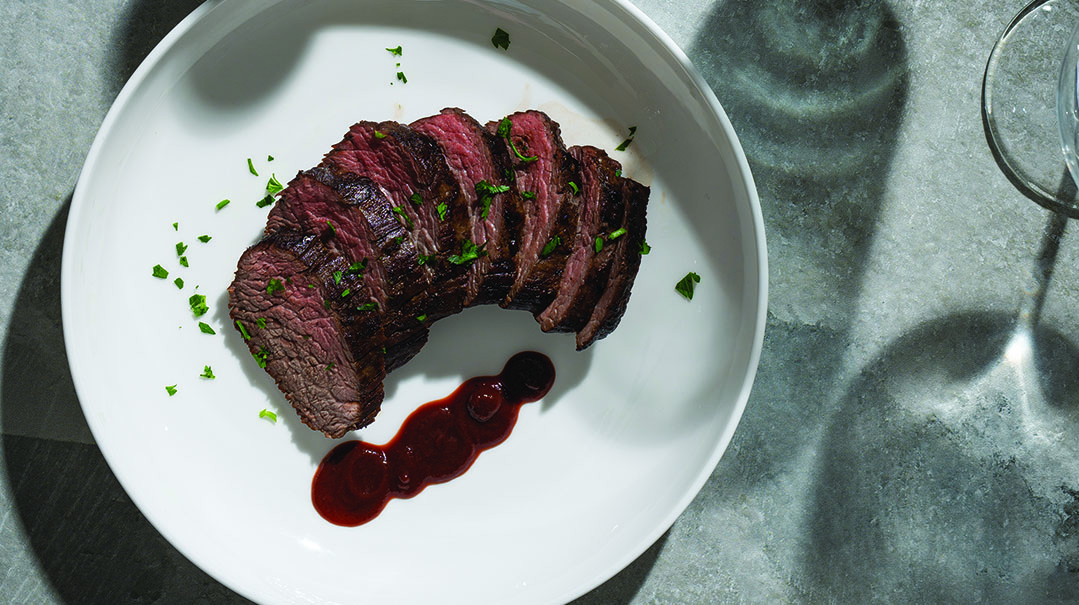
Dovid’s Koji Steak with Pan Sauce
YIELDS 1 MAIN COURSE SERVING
- ½ cup koji rice
- 1 lb (450 g) steak such as rib, oyster, or chateaubriand
- salt and pepper, to taste
Pan Sauce
- 1 Tbsp tomato paste
- 2 tsp brandy
- ½ cup chicken stock (preferably homemade)
- ½ cup red wine
Grind the koji rice in a blender. (I use a coffee grinder for best results.) Rub it all over the steak, covering the entire surface of the meat. Place on a cooling rack on a baking sheet in the fridge for two days. Remove the steak from the fridge. Using any flat utensil, scrape off the koji powder. Rinse off any leftover koji rice and dry the meat. Season it with salt and pepper, to taste.
Heat a pan over medium/high heat and cook the meat to desired doneness, making sure not to burn it. Remove the meat from the pan and set aside.
In the same pan, cook the tomato paste until it changes color. Pour the brandy into the pan and carefully use a lighter to set on fire. Wait until the flame dies down, then add in the stock and wine. Cook until thickened (about five minutes). Serve the steak with the pan sauce.
Duck Gnocchi with Mushroom-Onion Wine Sauce
SERVES 4 AS AN APPETIZER
- 2 duck legs
- 1 pkg frozen gnocchi
Mushroom-Onion Wine Sauce
- oil, for sautéing
- 1 large onion, diced
- 1 8-oz (225-g) container mushrooms, sliced
- ½ cup chicken stock (preferably homemade)
- ½ cup white wine
- 2 Tbsp duck sauce
- 1 Tbsp soy sauce
- 1 Tbsp orange juice
- salt and pepper, to taste
Allow the duck legs to sit in the fridge overnight, covered.
Preheat oven to 325°F (160°C).
Place duck legs in a cold, ovensafe frying pan. Place on the stove over low heat and cook until fat renders, 8–10 minutes.
Cover the frying pan and transfer it to the oven. Bake for 1 hour, covered. Remove the pan from the oven and baste the duck legs. Return the pan to the oven and cook the duck
for 1 more hour, or until fork-tender.
Shred the duck and set aside. To make the sauce: Heat oil in a saucepan and add the onion and mushrooms. Sauté over medium heat until very soft. Add the remaining sauce ingredients and stir to combine. Cook until reduced by half.
Cook the gnocchi according to package instructions, then transfer to a frying pan to crisp it up. Mix the gnocchi with
the shredded duck and the mushroom-onion sauce. Best served hot. Doubles well.
(Originally featured in Family Table, Issue 753)
Oops! We could not locate your form.

